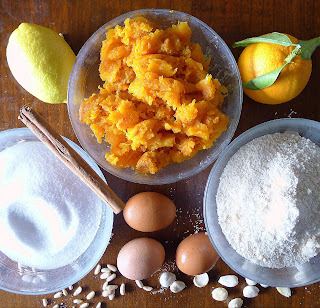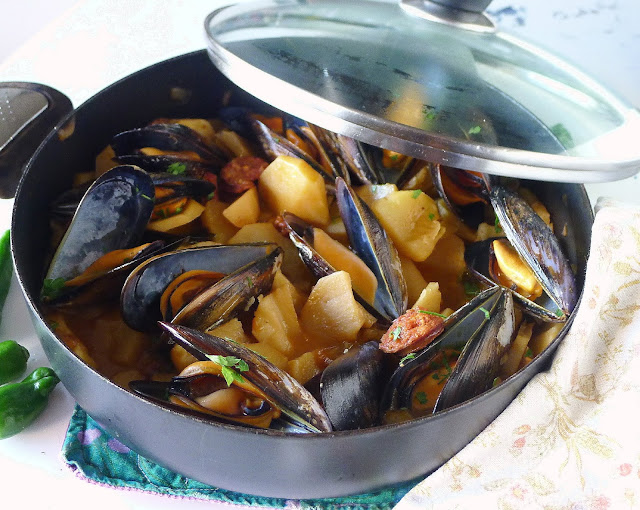 |
| A bouquet of mums from my garden to take to a friend's house. |
The vegetarian “roast,” still hot from the oven, was ready for its “beauty shot” before being carried to a friend’s house for Thanksgiving dinner. The gravy was ready. Pumpkin dessert defrosted (that recipe in last week’s blog). I packed a container of blue cheese schmear to go with endive leaves, a jar of garlicky, brine-cured olives and cranberry sauce sweetened with stevia (a visiting American brought me fresh cranberries). I bagged a bouquet of multi-colored chrysanthemums and a tablecloth.
I just had to whip the cream and I would be good to go.
But, you know how it is on Thanksgiving. Something always goes awry and a-whack. The cream whooshed up out of the blender container, splattering me, the walls, the counter-top and the floor. After clean-up, I hurriedly nestled the hot cazuela in a carry-crate, just as my ride arrived. (I’m not driving, as I had cataract surgery a couple days ago.) I forgot to take the photo. I forgot to take the camera with me.
“It looks like pineapple upside-down-cake,” said one dinner guest, as I placed the “roast” in the center of the table. In fact, it was a parsnip upside-down cake, gluten-free and dairy-free, consisting of brown rice, tofu, mushrooms, pistachios and seasonings, bound together with eggs (vegetarian, not vegan).
My “cake” started out to be a rice-nut loaf or a sage “stuffing,” with rice in place of bread. But a recipe in New York Times Cooking for a festive Thanksgiving torte inspired me to bake the mix in a springform pan and flip it out on a platter. (See that recipe here.)
I made up the recipe, tasting as I toasted, sautéed, mixed and seasoned. So, too, can you make variations to suit yourself.
I happened to have some sweet, black fermented garlic, so used it for drama (black accent) and umami kick. You could use truffles (!) or black olives. I used raisins, but dried cranberries would be lovely; or walnuts in place of pistachios. Go for Middle Eastern flavors instead of Midwestern, with chopped dill instead of parsley, with a pinch of cinnamon and cardamom instead of sage and thyme.
You could also skip the upside-down part—omit the parsnips and bake the rice mixture in a loaf pan. Or, omit the eggs and make a loose stuffing to serve alongside a roast bird. The baked rice with vegetables would also be a fine vehicle for leftover turkey—just substitute diced turkey for the tofu.
You could also add a filling to the rice, such as strips of piquillo pepper, hard-boiled eggs or sliced cheese. Spread half of the rice mixture over the parsnips, layer the filling on top, cover with remaining rice.
The recipe has many ingredients, but they’re divided into steps, most of which can be carried out a day in advance of baking. Taste as you combine the ingredients, adding seasoning to punch up flavor. Be generous with olive oil and salt to assure a moist and savory dish.
The whole-grain (brown) rice is cooked in three steps—first dry-toasted in a skillet, then simmered in liquid. Don’t overcook it at this point, because it finishes in the oven with the vegetables.
Smoked pimentón (paprika) and smoked tofu add meatiness to the rice and vegetable cake.
Use ordinary white mushrooms for the roast or sub in meaty portobellos or shitakes. Save the stems for the gravy, if desired.
Savory Upside-Down Cake with Rice and Mushrooms
Torta Salada al Revés con Arroz y Champiñones
Torta Salada al Revés con Arroz y Champiñones
 |
| Parsnips are sweeter than carrots. Sliced thinly, they are layered in the bottom of the springform pan. When unmolded, upside down, parsnips make the topping of the torta. |
Serves 8 as a main dish.
1 ½ pounds parsnips
Salt
Freshly ground black pepper
1 tablespoon olive oil
Salt
Freshly ground black pepper
1 tablespoon olive oil
2 ¼ cups brown rice (3 cups cooked rice)
8 cups boiling salted water
8 cups boiling salted water
6 tablespoons olive oil
1 cup diced carrots
1 cup chopped onions
1 cup diced celery
½ cup chopped red bell pepper
2 cloves garlic, chopped
½ pound mushrooms, chopped (3 cups)
8 ounces firm tofu (preferably smoked), chopped or crumbled
2 teaspoons smoked pimentón (paprika)
1 cup diced carrots
1 cup chopped onions
1 cup diced celery
½ cup chopped red bell pepper
2 cloves garlic, chopped
½ pound mushrooms, chopped (3 cups)
8 ounces firm tofu (preferably smoked), chopped or crumbled
2 teaspoons smoked pimentón (paprika)
2 teaspoons salt
Freshly ground black pepper
Crumbled sage (salvia)
Fresh thyme (tomillo)
½ cup chopped parsley
½ cup pistachios
2 tablespoons seedless raisins
1 teaspoon grated lemon zest
2 tablespoons chopped green onions or scallions
½ cup vegetable stock or mushroom broth (see recipe for gravy, below)
Black garlic, chopped (optional)
Freshly ground black pepper
Crumbled sage (salvia)
Fresh thyme (tomillo)
½ cup chopped parsley
½ cup pistachios
2 tablespoons seedless raisins
1 teaspoon grated lemon zest
2 tablespoons chopped green onions or scallions
½ cup vegetable stock or mushroom broth (see recipe for gravy, below)
Black garlic, chopped (optional)
Oil to grease pan
4 eggs, beaten
1 tablespoon pomegranate molasses (optional)
Gravy, to serve (optional) (recipe follows)
Cranberry sauce, to serve (optional)
4 eggs, beaten
1 tablespoon pomegranate molasses (optional)
Gravy, to serve (optional) (recipe follows)
Cranberry sauce, to serve (optional)
Cut off the skinny tails of the parsnips and save for another use. Peel the parsnips and cut them lengthwise in ¼-inch slices. Sprinkle them with salt and pepper and 1 tablespoon oil. (Sliced parsnips can be stored, covered and refrigerated, until following day.)
 |
| Toast the rice in a dry skillet until grains are lightly browned. |
Heat a heavy cast-iron skillet. Add the rice and toast it on medium heat, stirring frequently, until it is lightly browned. (Do not add oil or liquid.)
Add the toasted rice to boiling water. Cover and reduce heat and cook 10-12 minutes. Rice should be a little chewy, as it will cook further in the oven. Drain the rice thoroughly. Return it to the pan and cover. (Rice can be cooked a day in advance of baking the cake.)
 |
| Onions, carrots and mushrooms sautéed with tofu add flavour to the rice. |
Heat the oil in a skillet and sauté the carrots 2 minutes. Add the onions, celery, red pepper and garlic. Sauté them 5 minutes until onions are soft. Add the mushrooms and tofu and sauté 4 minutes longer. Stir in the pimentón. Remove the vegetables from the heat.
Combine the cooked rice and sautéed vegetables in a mixing bowl. Add salt, pepper, sage, thyme, parsley, pistachios, raisins, lemon zest, chopped green onions and vegetable stock. If using black garlic, save three cloves of it to place beneath the parsnips. Cut the remaining cloves into 2 or 3 pieces and mix with the rice. (Rice-vegetable mix can be prepared a day in advance of baking and stored, covered and refrigerated.)
When ready to bake the upside-down cake, preheat oven to 400ºF. Lightly oil a springform pan (10- 11- or 12-inch). Line it with a round of baking parchment. Oil the parchment and sides of the pan.
 |
| Layer thinly sliced parsnips in bottom of a springform pan. The black bits are cloves of sweet black garlic. |
Arrange the sliced parsnips, slightly overlapping, in the bottom of the pan. (If using black garlic, place 3 of them under the parsnips, so they show when the cake is unmolded.)
Add the beaten eggs to the rice-vegetable mixture. Mix well. Spread half of the rice mixture over the parsnips and press it down firmly. Add remaining mix and smooth the top.
Cover the springform pan with foil. Bake 50-60 minutes. Parsnips in bottom of pan should feel tender when tested with a long skewer and rice should be set. Remove foil and bake 15 minutes longer. Remove the pan from the oven.
Heat broiler to 500ºF. Have ready an oven-safe serving dish, such as a cazuela.
When the springform pan is cool enough to handle, loosen the sides of the cake with a knife, release the spring and remove the outer rim. Very carefully invert the cake onto the serving dish. Drizzle the parsnips with the pomegranate molasses, if using. Place the dish under the broiler until the parsnips begin to brown in spots, 3-4 minutes.
Remove from broiler. Serve hot or room temperature, with gravy and cranberry sauce, if desired.
Vegetarian Mushroom Gravy with Sherry
Salsa de Champiñones al Vino de Jerez
Salsa de Champiñones al Vino de Jerez
You will need vegetable stock for this gravy. I made mine with onions with skins on (for color), carrots, celery root (celeriac), leek and herbs and spices. Add a slosh of vinegar and salt to taste. Simmer 45 minutes and strain the stock.
Browning the onions very slowly is what gives the gravy its deep color. Adding a little sugar to caramelize deepens the color (you can omit it, if preferred). In cooking, the liquid reduces by about a third. Pureeing the vegetables thickens the gravy—no need for flour or cornstarch.
The gravy may not need salt after liquid has been reduced. Taste for salt after the gravy has been cooked and pureed.
2 tablespoons olive oil
1 ½ cups chopped onions
½ cup chopped carrot
½ cup chopped mushrooms
2 cloves garlic, chopped
2 teaspoons sugar (optional)
½ cup dry Sherry
3 cups vegetable stock
1 tablespoon soy sauce
1 tablespoon tomato sauce (tomate frito)
Sprig of parsley
1 bay leaf
Freshly ground black pepper
Salt to taste
1 ½ cups chopped onions
½ cup chopped carrot
½ cup chopped mushrooms
2 cloves garlic, chopped
2 teaspoons sugar (optional)
½ cup dry Sherry
3 cups vegetable stock
1 tablespoon soy sauce
1 tablespoon tomato sauce (tomate frito)
Sprig of parsley
1 bay leaf
Freshly ground black pepper
Salt to taste
Heat the oil in a skillet and slowly sauté the onions, carrots, mushrooms and garlic, stirring frequently, until onions are dark brown. Don’t let them burn. Add the sugar and stir until sugar caramelizes. Stir in half of the Sherry.
Scrape all of the onion mixture into a saucepan. Add the remaining Sherry, stock, soy sauce, tomato sauce, parsley, bay and pepper. Cook, uncovered, until vegetables are very tender, 20 minutes. Discard parsley and bay leaf.
Use a hand-held blender to blend the gravy until smooth. Taste and add salt, if needed.
Gravy can be prepared a day in advance of serving. Reheat before serving, adding additional water or stock if necessary.
More recipes for vegetarian mains:
Vegetarian Burgers. (This mix can also be used for a loaf.)
More about black garlic:




























